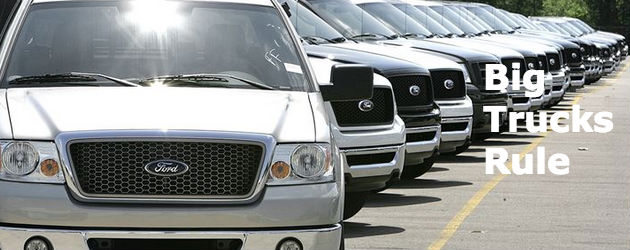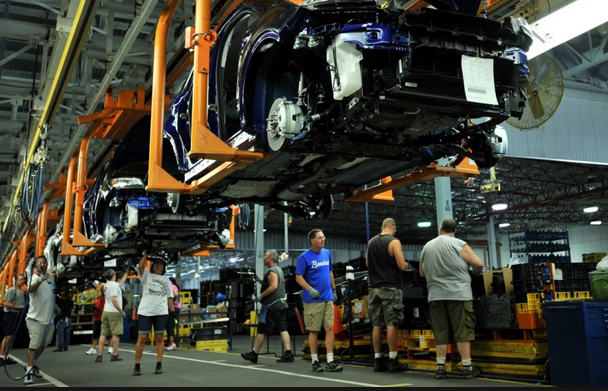Big Trucks Still Rule Detroit in Energy-conscious Era
 Courtesy of Reuters: Full-size pickups and SUVs still account for more than two-thirds of U.S. automakers’ global pre-tax earnings
Courtesy of Reuters: Full-size pickups and SUVs still account for more than two-thirds of U.S. automakers’ global pre-tax earnings
Five years into a remarkable rebound from near-disaster, the Detroit 3 automakers still count on sales of pickup trucks and SUVs in the North American market for the bulk of their global profits, despite efforts to shift buyers into smaller, greener vehicles as part of a broader move to remake the Motor City.
Promotion of green technologies, notably hybrid and electric vehicles, has been a signature policy of the Obama administration, which oversaw the $80 billion taxpayer-funded bailout in 2009 of General Motors and Chrysler.
Those same U.S. taxpayers, however, have shown a marked preference for big trucks such as the best-selling Ford F-150 over cleaner, more economical “electrified” vehicles such as the Chevrolet Volt.
Full-size pickups and SUVs remain a pillar of profitability in Detroit, accounting for more than two-thirds of U.S. automakers’ global pre-tax earnings, a Reuters analysis indicates, even though they make up just 16 percent of North American vehicle production.
“There is no doubt that full-size trucks are still the single largest component” of pre-tax profits at General Motors Co, Ford Motor Co and Chrysler Group LLC, a unit of Italy’s Fiat SpA, according to Sterne Agee auto analyst Michael Ward.
Representatives at the three automakers confirmed that assessment but declined to provide specifics.
Even so, the Obama administration does not see the trend as counter-productive to its green-tech initiatives. Since GM and Chrysler emerged from bankruptcy, U.S. automakers and parts suppliers have added tens of thousands of jobs and invested in advanced technology, said White House spokesman Keith Maley.
“At the same time, the administration has put forward new fuel-economy standards that have helped drive down oil consumption and save consumers money at the pump,” Maley said in an email when asked whether the popularity of trucks runs counter to the goal of putting more green cars on U.S. roads.
SALES JUMP
 Still, with the notable exception of the Toyota Prius, many of the electric and hybrid vehicles on sale in the United States remain money-losers, say analysts and executives, with the sector this year accounting for less than 4 percent of total volume, despite price wars and government tax incentives.
Still, with the notable exception of the Toyota Prius, many of the electric and hybrid vehicles on sale in the United States remain money-losers, say analysts and executives, with the sector this year accounting for less than 4 percent of total volume, despite price wars and government tax incentives.
The continued strength of big trucks is remarkable in an era of tightening fuel-economy regulations and public policy moves intended to promote green cars. In a rising U.S. auto market that was up 8 percent in the first nine months, sales of full-size pickups jumped 20 percent from the previous year.
The automakers have been able to maintain higher margins on their trucks, in part, because they have been in relatively short supply – a consequence of cuts in North American production capacity over the past five years.
“In the past, truck profits masked a lot of rot in Detroit’s core business – overcapacity, weak brands, lousy quality,” said a former Ford official who asked not to be identified.
But Detroit has cleaned up its act since the Great Recession, sweeping away weaker brands, slashing overhead, boosting quality and adding premium products and features.
Consumers are responding by buying more expensive trucks. Ford said nearly 40 percent of its F-series pickups in the U.S. market sell for $40,000 or more; the figure at GM is 30 percent and rising. As a result, pre-tax margins are flowing straight to the bottom line.
Reuters calculated the pre-tax contribution of trucks to companies’ EBIT – earnings before interest and taxes – using a conservative per-vehicle profit estimate of $6,000, multiplied by the number of large trucks and SUVs produced by each company in North America, where nearly all those vehicles are sold.
MASSIVE PROFITS
Using that formula, big trucks and SUVs at the Detroit 3 last year contributed an estimated $13.7 billion, or roughly 71 percent, of the automakers’ combined global EBIT of $19.2 billion. The percentage remained the same through the first nine months of 2013: $11.7 billion, or 71 percent of the combined global EBIT of $16.5 billion, according to Reuters calculations.
The resilience of big trucks – and the U.S. automakers’ dependence on them for the bulk of their profits – raises questions about Detroit’s ability to mitigate future risks to those vehicles, from spikes in oil prices to more restrictive fuel-economy standards.
Detroit’s reliance on trucks “has burned them in the past when market shifts occurred,” said Jeff Schuster, senior vice president of forecasting at research firm LMC Automotive.
As a hedge, more product diversification “is critical to capture new buyers, expand scale and grow volumes,” said Michael Robinet, managing director of IHS Automotive Consulting.
But U.S. consumers do not seem inclined to walk away just yet from big pickups, which are providing a brisk business at dealerships such as Joe Rizza Ford in Orland Park, Illinois.
“We’re seeing all types of folks – blue-collar workers, retirees, single mothers,” said Rizza sales manager Brian Schwarz. “The older buyers want all the goodies on their trucks. The moms like the fact that they’re big and safe, and they ride like a car, not a Mack truck.”
STILL DEPENDENT
Some companies are more dependent on trucks than others, the Reuters analysis shows.
Big trucks and SUVs at GM, from the Silverado to the Suburban, last year contributed an estimated $5.66 billion, or roughly 67.7 percent of the company’s global EBIT. The figure for the first nine months of 2013 was an estimated $5.06 billion, with share of global EBIT rising to 71.6 percent.
GM earlier this year introduced redesigned versions of its standard Silverado and Sierra pickups as 2014 models. The trucks carry higher transaction prices, which could climb even more once the new range-topping Silverado High Country and Sierra Denali versions reach U.S. dealers this month.
And because the automaker has lowered its break-even point in North America and will introduce new heavy-duty pickups and redesigned SUVs early next year, if demand continues to rise as expected, “GM will be printing money,” wrote Morningstar auto analyst David Whiston in an October client briefing.
The company also invested heavily in Cadillac, expanding its range of premium products and promoting the brand outside North America, especially in China.
“This is a much healthier company – more efficient and more geographically diverse in terms of earnings,” said GM spokesman James Cain.
In the meantime, the U.S. Treasury Department plans to sell its remaining stake in GM – a legacy of the 2009 bailout – by early next year. Treasury did not respond to a request for comment on large trucks as the principal source of GM’s profits.
HEDGING RISK
Ford, whose F-series pickup has been the best-selling U.S. vehicle for more than three decades, relies less on trucks for its profit, although the contribution remains significant.
Last year, trucks and SUVs contributed an estimated $5.53 billion, or 69.4 percent of Ford’s global EBIT. This year, as discounts have risen as high as $9,000 on the aging F-series, the profit contribution has dipped to $4.55 billion, or about 62.4 percent of global EBIT.
Analysts are less certain Ford can maintain or increase that level because it is introducing a redesigned F-series pickup that’s expected to make extensive use of aluminum. The new design and the lighter material could turn off consumers, especially construction workers and others who value the rugged looks and durability of the current 2014 F-series.
To help hedge the risk, Ford has staggered the introduction of the new F-series at its two U.S. trucks plants, according to suppliers familiar with the automaker’s plans. It will begin building the all-new 2015 model at its Dearborn, Michigan, plant next August, they said, while carrying over the mostly unchanged 2014 model at its Kansas City plant until March 2015.
Chrysler’s case is unique. For one, its fortunes are controlled by parent Fiat, which continues to rack up substantial losses in Europe. For another, big trucks account for a much smaller portion – just 19 percent – of the company’s North American vehicle production.
But truck profits have a maximum impact at Chrysler, contributing an estimated $2.53 billion last year, or about 86.9 percent of Chrysler’s 2012 EBIT. That number in the first nine months was $2.10 billion – virtually 100 percent of the company’s EBIT so far this year.
Small wonder that Fiat CEO Sergio Marchionne is so eager to consolidate the two companies.
Category: Featured, General Update










